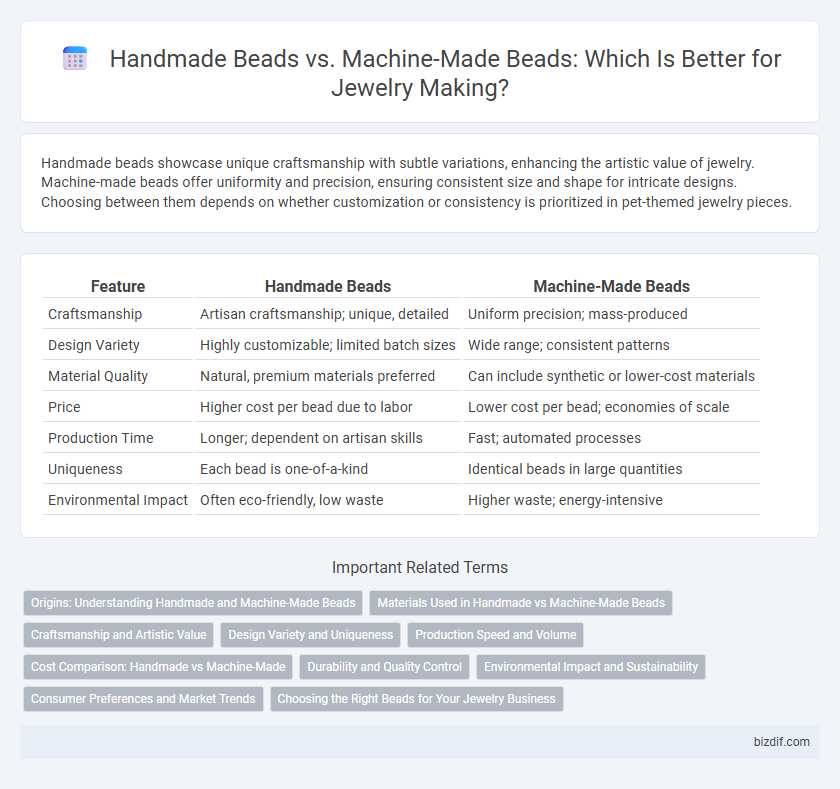Handmade beads showcase unique craftsmanship with subtle variations, enhancing the artistic value of jewelry. Machine-made beads offer uniformity and precision, ensuring consistent size and shape for intricate designs. Choosing between them depends on whether customization or consistency is prioritized in pet-themed jewelry pieces.
Table of Comparison
| Feature | Handmade Beads | Machine-Made Beads |
|---|---|---|
| Craftsmanship | Artisan craftsmanship; unique, detailed | Uniform precision; mass-produced |
| Design Variety | Highly customizable; limited batch sizes | Wide range; consistent patterns |
| Material Quality | Natural, premium materials preferred | Can include synthetic or lower-cost materials |
| Price | Higher cost per bead due to labor | Lower cost per bead; economies of scale |
| Production Time | Longer; dependent on artisan skills | Fast; automated processes |
| Uniqueness | Each bead is one-of-a-kind | Identical beads in large quantities |
| Environmental Impact | Often eco-friendly, low waste | Higher waste; energy-intensive |
Origins: Understanding Handmade and Machine-Made Beads
Handmade beads originate from traditional artisan techniques involving hand shaping, curing, and decorating, often reflecting cultural heritage and unique imperfections. Machine-made beads are produced through automated industrial processes ensuring uniformity, consistent size, and mass production efficiency. Understanding these origins highlights the value of craftsmanship in handmade beads compared to the precision and scalability of machine-made beads in jewelry making.
Materials Used in Handmade vs Machine-Made Beads
Handmade beads often use natural materials like glass, clay, wood, and semi-precious stones, providing unique textures and organic imperfections that enhance their artisanal value. Machine-made beads typically involve synthetic materials such as plastic, resin, or uniform glass, ensuring consistent size, shape, and color for mass production. The choice between handmade and machine-made beads significantly impacts the authenticity, durability, and aesthetic appeal in jewelry making.
Craftsmanship and Artistic Value
Handmade beads showcase exceptional craftsmanship through unique imperfections and intricate details that reflect the artisan's skill and creativity. Machine-made beads offer uniformity and precision but often lack the individual artistic value imbued in handcrafted pieces. The choice between handmade and machine-made beads significantly impacts the authenticity and emotional resonance of jewelry designs.
Design Variety and Uniqueness
Handmade beads offer unparalleled design variety and uniqueness due to their artisanal creation process, resulting in distinct shapes, textures, and color patterns that cannot be exactly replicated. Machine-made beads typically exhibit uniformity and consistency, which limits the diversity of designs but ensures compatibility for mass-produced jewelry. Choosing handmade beads enhances the individuality and artistic value of jewelry pieces, appealing to those seeking one-of-a-kind accessories.
Production Speed and Volume
Handmade beads require meticulous craftsmanship, resulting in slower production speed and lower volume compared to machine-made beads. Machine-made beads leverage automated processes, enabling rapid manufacturing and consistent high-volume output suitable for large-scale jewelry production. This efficiency difference significantly impacts supply chains and pricing structures in the jewelry industry.
Cost Comparison: Handmade vs Machine-Made
Handmade beads typically involve higher production costs due to labor-intensive techniques and unique craftsmanship, resulting in premium pricing. Machine-made beads benefit from automated mass production, significantly reducing manufacturing expenses and offering lower retail prices. Choosing between handmade and machine-made beads depends on budget constraints and the desired value of artisanal quality versus affordability.
Durability and Quality Control
Handmade beads often exhibit superior durability due to meticulous craftsmanship and the use of higher-quality materials, which ensures each bead can withstand wear over time. Quality control is more precise in handmade bead production, as artisans inspect each bead individually for flaws and consistency, contrasting with machine-made beads that may have uniformity but often sacrifice meticulous quality checks. The unique imperfections in handmade beads enhance their aesthetic value while maintaining durability, making them preferable for high-end, custom jewelry pieces.
Environmental Impact and Sustainability
Handmade beads typically have a lower environmental impact compared to machine-made beads due to their artisanal production methods, which often use natural or recycled materials and avoid large-scale industrial energy consumption. The sustainability of handmade beads is enhanced by the support of local artisans and the reduced carbon footprint associated with small-batch production. Machine-made beads, while consistent in quality and quantity, often rely on mass production processes that contribute to resource depletion and increased waste.
Consumer Preferences and Market Trends
Handmade beads offer unique imperfections and artisanal value that appeal to consumers seeking individuality and craftsmanship in jewelry making. Machine-made beads provide consistent quality, uniformity, and affordability, driving mass-market popularity and accessibility. Market trends indicate a growing demand for handmade beads in niche segments, while machine-made beads dominate mainstream retail due to scalability and cost-effectiveness.
Choosing the Right Beads for Your Jewelry Business
Handmade beads offer unique textures and slight variations that appeal to customers seeking artisanal quality, making them ideal for high-end or custom jewelry lines. Machine-made beads provide uniformity, precision, and cost-efficiency, supporting large-scale production and consistent inventory. Selecting between handmade and machine-made beads depends on your target market's preferences, production volume, and desired price point to optimize product appeal and profitability.
Handmade beads vs machine-made beads Infographic

 bizdif.com
bizdif.com